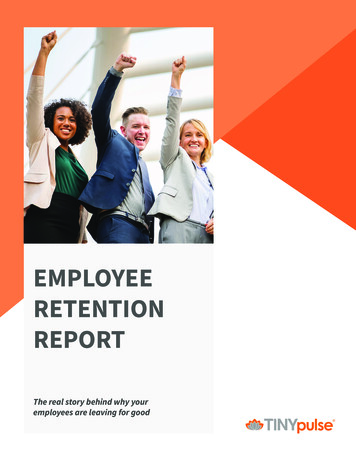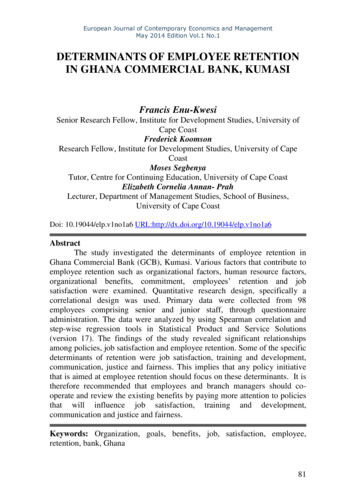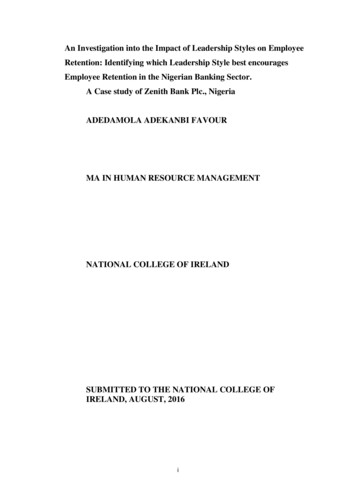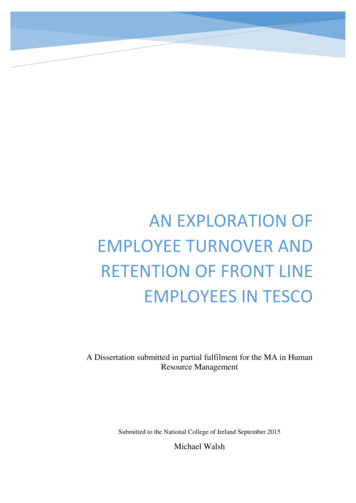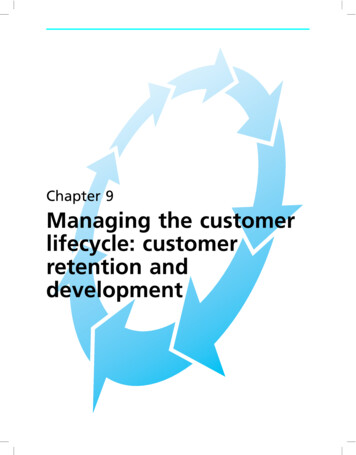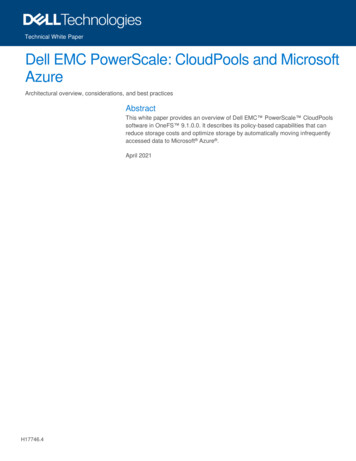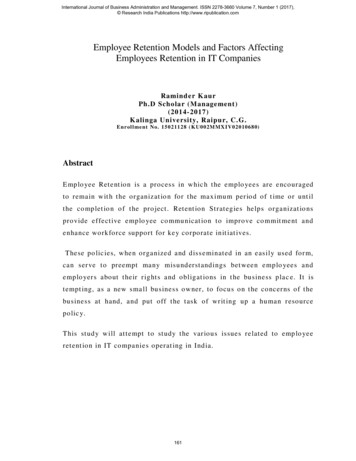
Transcription
International Journal of Business Administration and Management. ISSN 2278-3660 Volume 7, Number 1 (2017), Research India Publications http://www.ripublication.comEmployee Retention Models and Factors AffectingEmployees Retention in IT CompaniesRamind er K aurPh.D Scholar (Management)(2014-2017)K alinga University, Raipu r, C.G.En r ol l me n t No. 1 5 0 2 1 1 2 8 ( K U0 0 2M MX I V0 2 0 10 6 8 0)AbstractE mplo yee Ret ent ion is a proces s in whic h t he emplo yees are encouragedto remain wit h t he organizat io n for t he maximum per io d of t ime or unt ilt he co mplet io n o f t he pro ject . Ret ent ion St rat egies helps organizat io nsprovide effect ive emplo yee co mmunicat ion t o improve co mmit ment andenhance workforce support for key corporat e init iat ives.These po lic ies, when organized and diss eminat ed in an easily used for m,can ser ve t o preempt many misunderst andings bet ween emplo yees andemplo yer s about t heir r ight s and obligat ions in t he business plac e. It ist empt ing, as a new sma ll business owner, to focus on t he concer ns of t hebusiness at hand, and put off t he t ask of wr it ing up a human r esourcepolic y.This st udy will at t empt t o st udy t he var ious issues relat ed to emp lo yeeret ent ion in IT companies operat ing in I ndia.161
International Journal of Business Administration and Management. ISSN 2278-3660 Volume 7, Number 1 (2017), Research India Publications http://www.ripublication.com1. IntroductionSult ana Nazia & Bushra Begum (2013) 1 had given in t heir paper t hatE mplo yee ret ent ion is an effort by a business t o maint ain a workingenvironment which support s current st aff in rema ining w it h t he co mpany.Many e mplo yee ret ent io n po licies are aimed at addressing t he var iousneeds o f emplo yees t o enhance t heir job sat isfact ion and reduce t hesubst ant ial cost s invo lved in hir ing and t raining new st aff.It is a process in which t he emplo yees ar e encouraged t o remain wit h t heorganizat io n for t he maximum per iod o f t ime or unt il t he co mplet io n o ft he pro ject . Ret ent io n St rat egies helps organizat io ns provide effect iveemplo yee co mmunicat ion t o improve co mmit ment and enhance workforcesupport for key corporat e init iat ive s.According t o Get Les McKeon, emplo yee ret ent ion is defined as " Asyst emat ic effort by emp lo yer s t o creat e and fo st er an environment t hatencourages current emplo yees t o remain emplo yed by having po lic ies andpract ices in p lace t hat address t heir diverse needs. T he cost s associat edwit h t urno ver ma y inc lude lo st cust omer s, business and damaged morale.In addit io n, t here are t he hard cost s of t ime spent in screening, ver ifyingcredent ials,refer ences,int er viewing,hir ingandt rainingt henewemplo yee just to get back t o where you st art ed.‖Also o f concer n are t he cost s of employee t urno ver ( including hir ingcost s& product ivit y loss). Replacement cost s usually are 2.5 t imes t hesalar y o f t he ind ividual. T herefore, emplo yee ret ent io n is effort by abusiness t o maint ain a working environment which support s current st affin rema ining wit h t he co mpany.Sultana Nazia&Bus hr a Begu m (2013 ), “EMPLOYEE RETENTION PRACTICES ININDIAN CORPORATE – A STUDY OF SELECT MNCs‖, International Journal of Engineeringand Management Sciences, Vol 4 N0 3, pp. 361-368.1162
International Journal of Business Administration and Management. ISSN 2278-3660 Volume 7, Number 1 (2017), Research India Publications http://www.ripublication.com2. Objectives and Research MethodologyObjectives of Studyi. Examinet hescenar ioofE mp lo yeesRet ent io nin I ndian ITco mpanies.ii. Ident ify t he major models o f E mplo yee s‘ Ret ent io n.iii. To find out t he major fact ors affect ing t he E mplo yees ret ent ion inIT companies.Research MethodologyResearch met hods can be classified in different ways, t he mo st commo ndist inct io n is bet ween t he quant it at ive and t he qualit at ive approache s(Myers, 2007 2). Quant it at ive approaches were or igina lly used whilest udying nat ural sciences like: laborat ory exper iment s, sur vey met hodsand numer ical met hods. A qua lit at ive st udy is used when t he researcherwant s to get a deeper under st anding on a spec ific t opic or sit uat io n. Myer s(2007) 3 st at ed t hat t he qualit at ive appr oach was developed in socialsciences in order t o support t he researcher in st udies inc luding cult ur a land social pheno mena. Sources included in t he qualit at ive approach ar eint er views, quest io nnaires, obser vat ions, document s and t he r esearcher‘simpressio n and react ions. The chosen appr oach is qualit at ive.Qualitative research t ypically t akes t he for m o f in -dept h int er views wit ha sma ll number o f respondent s. T hese int er views ma y be do ne oneindividual at a t ime, or in groups. Individual int er views have t headvant ages o f pro viding ver y r ich infor mat io n and avo iding t he influenceof ot hers on t he opinio n o f any one individual. Individual int er views arever y expensive and t ime consuming, however, and as a result , it is not2Myers, M. D. (2007), ―Qualitative Research in Information Systems‖, MIS Quarterly, vol. 21 No. 2,pp.241-242.3Ibid163
International Journal of Business Administration and Management. ISSN 2278-3660 Volume 7, Number 1 (2017), Research India Publications http://www.ripublication.comlikely t hat any one research program will int er view lar ge number o findividuals.3. Models of Employees’ RetentionThere are t hree import ant models on employee r et ent io n, one o f t hem is a)Zinger Model and t he ot her is 2 ) ERC‘s Ret ent ion Model. 3) I nt egrat edS yst em for Ret aining E mplo yees. A br ief explanat ion o f t hese models isfo llo ws:Zinger Model: E mplo yee ret ent ion is t he art and science of engagingpeople in aut hent ic and r ecognized connect io ns t o st rat egy, ro les,per for mance,organizat io n,co mmunit y,relat io nship,cust omers,development , energy, and well- being as companies leverage, sust ain, andt ransfor m t heir work connect io ns int o result s.Figur e 1: Ginger ModelSource: Sult anaNazia & Bushra Begum (2013) 4Sultana Nazia&Bus hr a Begu m (2013 ), “EMPLOYEE RETENTION PRACTICES ININDIAN CORPORATE – A STUDY OF SELECT MNCs‖, International Journal of Engineeringand Management Sciences, Vol 4 N0 3, pp. 361-368.4164
International Journal of Business Administration and Management. ISSN 2278-3660 Volume 7, Number 1 (2017), Research India Publications http://www.ripublication.comAcco rding t o t he Zinger Model, emplo yee ret ent ion is direct ed t owardsachieving result s o f t he organizat ion t hat t he depart ment , t eam, orindividual want s t o achieve. To achieve r esult s, co mpanies need t o craft ast rat egy to get t here .A cent ral key of emplo ye e ret ent ion is connect io n.In so me cases connect io n is syno nymous wit h engage ment . Engagement isnot a one t ime sur vey measur e or a st eady st at e. To engage is t o full yexper ience and co nt r ibut e to t he dynamic element s o f work.E mplo yee r et ent io n mustbe a ut hent ic and r et ent io n o f co mpet entemplo yee requires power ful recognit io ns. A ro le is a set of behavior s,r ight s and obligat io ns at work companies must guard against t oo manyroles or ro le over lo ad while also fully being in t he roles t hat cont ribut e t oresult s, relat ionships, and engagement . Thos model emphasizes t hatemplo yee ret ent io n can co nt r ibut e t o effect ive per for mance managementand per for mance demo nst rat es company‗ s engagement while engagementand ret ent io n can help co mpanies excel at perfor mance. Good emplo yeeret ent ion should fost er st ar per for mer s.The emplo yee should also align w it h t he o rganizat io n so as t o build up t heest eem o f t he organizat ion and t here should not be a disconnect bet wee nemplo yee and organizat io n. Co mpanies want emplo yees t o ser ve t heircust omers and t his is a ver y st rong relat ionships bet ween emplo yeeengagement and emplo yee ret ent ion. E ffect ive E mplo yee ret ent ion helpsto serve cust omers a lot . The mo del comment s t hat emplo yees shouldexper ience bot h personal and pro fessio nal development t hrough workrang ing fro m courses and lear ning t o develop t heir own st rengt hs, value,vis ibilit y, and engagement . Power ful ret ent ion invo lves mast er y o fphys ical, ment al, emot ional, spir it ual, and organizat ional energy. Workshould co nt r ibut e to emplo yee well- being. E mplo yees need t o bot h engagein and exper ience healt hy well being. An organizat io n‘s r esult s aredependent upon t he healt h and product ivit y o f individual emplo yees.165
International Journal of Business Administration and Management. ISSN 2278-3660 Volume 7, Number 1 (2017), Research India Publications http://www.ripublication.comERC' s Retention ModelE mplo yeeRet ent ionConnect ion'smo delco ncent rat esonappliedorganizat io nal exper ience ind icat ing t hr ee pr imar y dr iver s o f emplo yeeret ent ion. ·Work can bemade st imulat ing by giving var iet y o fassignment s, aut onomy t o make decis io ns, resources and support providedtodogoodwork,opport unit ytolearn,feedbackonresu ltandunderst anding t he significance of one's personal co nt ribut ions.Figur e 2: ERC Ret ent ion ModelSource: As abo ve figureMot ivat io nal Leader ship also helps r et ain emplo yees t her efore leader sshould champio n change and must be open t o new ideas. They shouldinspire a shared vis io n o f organizat ion direct ion, develo p t he capabilit iesof ot hers and beco me a model for a behavior s t hat reflect s organizat io nvalues. Co mpanies should recognize and reward a jo b t hat is done wel land should reinforce desired behavio urs and cr eat e an e mphasis and focuson recognit io n. T he y should celebrat e successes in order t o build se lfest eem and enhance camar ader ie and t eam work.166
International Journal of Business Administration and Management. ISSN 2278-3660 Volume 7, Number 1 (2017), Research India Publications http://www.ripublication.comIntegrat ed System for Retaining Emp loyeesThe E mplo yee Ret ent ion C onnect ion t ransfor ms t he organizat io n cult ur eand enhances t he co mpet it ive edge t hr ough t he fo llow ing five -phasedapproach: ERC begins by ana lyzing t he organizat ion‘s mot ivat io n andret ent ion cult ure t hrough sur veys and fo cus groups t hat is t he mot ivat ingand demot ivat ing aspect s o f t he cult ur e. ERC concent rat es on designinghigh- invo lve ment jo b and work assignment s and t rains super visors andmanager s in proven met hods of mot ivat ional leadership.Figur e 3: Int egrat ed Ret ent io n S yst emSource: IbidS inha a nd S inha (2012) 5 in t heir paper had given major fact or t hatcont r ibut e t o ret ent ion o f E mplo yees. T hey have ment io ned Agrela, et al(2008) st at es t he need t o focus o n t he fact ors t hat affect s ret ent ion leadingChandranshuSinha and RuchiSinha (2012), ―Factors Affecting Employee Retention: AComparative Analysis of Organizations‖, European Journal of Business and Management, Vol 4,No.3, pp. 145-160.5167
International Journal of Business Administration and Management. ISSN 2278-3660 Volume 7, Number 1 (2017), Research India Publications http://www.ripublication.comto growt h and success o f organizat ions. St udie s suggest s t hat ret ent io nst rat egies,whicheffect ivelysat isfyt heneedsofa llemp lo yeesconsequent ly enhances t he abilit y for co mpanies t o adapt more effect ivel yto ongoing organizat io nal change (Gale Group, 2006). Research showst hatt rendst radit io nalr edefiningsalar yandmoder nret ent ionbenefit spackagest rat egies(GalegoGroup,beyo ndt he2006)andco mpensat io n (Feld man, 2000) embracing emplo yee mot ivat ion (Tho mas,2000), as o ne o f t he ke y fact ors to cat er to t he diversit y and lo ng st ay o ft he workforce in t he organizat ion. Ret ent io n fact ors incorporat ing t heneeds and desires of emp lo yees at any age enhance levels o f individualjo b sat isfact io n, lo yalt y, and co mmit ment (Boomer Aut hor it y, 2009).Cunningham (2002) st at es t hat emplo yees rank emplo yee recognit io n,flexibilit y and t raining as t op prior it ies for pro longing individua lemplo yment , while Walker (2001) and ot hers call for est ablishing asupport ive lear ning and working climat e for emp lo yee ret ent ion. Furt her,career development (Boomer Aut hor it y 2009), organizat ional co mmit ment(Pat rick Owens, 2006), co mmunicat io n (Gopinat h and Becker, 2000) andsuper ior- subordinat e relat ionship ( Zenger , Ulr ich, S ma llwood, 2000) arealso t he fact ors known for prolonged st ay of t he emplo yees in t heorganizat io n.4. Factors affecting Employees RetentionThe list o f ret ent io n fact ors and lit er at ure review is not meant t o beexhaust ive o f all possible t heor ies or var iables r elat ed t o emplo yeeret ent ion and t urnover (Gr iffet h et al., 2000). Rat her, t he emphasis in t hisst udy is placed o n t est ing t he relat ive frequency wit h which var iousret ent ion fact ors emerge when analyzing emplo yees‘ vers io ns for whyt hey st ay. A br ief int roduct io n and review of t he 12 ret ent ion fact orsworking t owards t he preser vat io n o f an orga nizat io ns most valuable asset168
International Journal of Business Administration and Management. ISSN 2278-3660 Volume 7, Number 1 (2017), Research India Publications http://www.ripublication.com– emplo yees (Yazinski, 2009), examined in t his st udy are pro vided in t hefo llo wing sect ion.i. Skill recognitionProviding skill recognit io n o f perso nal jo b acco mplishment s is aneffect ive ret ent io n st rat egy for emplo yees at a ny age (Yazinski, 2009).St udies indicat e fulfilling peoples need for accept ance by acknowledgingindividual work acco mplishment s pro longs emplo yment o f emplo yees(Redingt on, 2007). A St udy by Yaz inski (2009) show t rends o f anincr eased number o f jo b applicant s seeking out co mpanies t hat encourageemplo yee input , growt h, educat ion, and t eamwork, be yo nd t he t radit io nalco mpensat io n/ benefit packages offer ed by emplo yer s.ii. Learning & Working Cli mateS ince lear ning and development opportunit ies appear cruci a l for t heret ent ion o f t alent ed emplo yees (Ar no ld, 2005; Hyt t er, 2007; Walker,2001), an organisat ion must est ablish a support ive lear ning and workingclimat e. T he concept ―lear ning and working climat e‖ is der ived fro mprevious research ( Abrams et al., 20 08 et c). In general it refers t o t heenvironment wherein emp lo yees bot h lear n and work.iii. Job Flexibi lityJob flexibilit y is vit al for r et aining emplo yees o f any age (BoomerAut hor it y, 2009). Researchers descr ibe t he import ance of emplo ymentflexibilit ysuchasschedulingvar iat ionst hatbet t eracco mmodat eindividual work t imes, workloads, responsibilit ies, and locat ions aroundfamily r espo nsibilit ies (Cunningham, 2002; P leffer, 2007). St udies showt hat "flexibilit y" empower s individuals t o facilit at e a healt hier balancebet ween work and personal obligat ions, somet hing t hat appeals t o all agesof emplo yees (E yst er, et al., 2008; Scheef&T hielfo dt , 2004).169
International Journal of Business Administration and Management. ISSN 2278-3660 Volume 7, Number 1 (2017), Research India Publications http://www.ripublication.comiv. Cost Effectiven essSt udiessupport st heconclusio nt hatorganizat ionsprovidingcosteffect ive jo b flexibilit y opt ions benefit from sat isfying t he needs o f al lemplo yees, independent of age, which allows for t he reallo cat io n o fexpensesrelat edabsent eeis m,andtorecruit ment ,co mmut ingworkcost sspace(Agr ela,etchanges,al.,sick2008;t ime,Boo merAut hor it y, 2009; Cunningha m, 2002).v. TrainingTraining is a key r et ent io n fact or for emplo yees at any age. St at ist ica levidenceindicat esjo bt rainingisacr it icalfact orforpersona l(behavioral) and pro fessio nal (t echnical) development (Unit ed St at esDepart ment of Labor, 2009). The availabilit y for all emplo yees havingaccess t o training and development programs is cr it ical in facilit at ingorganizat io nal growt h, part icular ly wit h per for mance and t echno logica limprovement s (Boomer Aut hor it y, 2009).vi. BenefitsThe relat io nship of benefit s wit h ret ent ion is anot her aspect of makingpeoplest ay is o ft en invest igat edby researcher s.Maccoby (1984)ident ified t he jo b sat isfact io n of employees and super visors o f Bel lS yst em o ver a five- year per iod and found t hat t he emplo yees andsuper visor s were sat isfied wit h t heir pay and benefit s and were a lsomot ivat ed to work product ive ly.vii. Career Develop mentThe purpose o f career planning as part of an emplo yee developmentprogram is not only t o help emplo yees feel like t heir emp lo yer s areinvest ing in t hem, but also help people manage t he many aspect s of t heir170
International Journal of Business Administration and Management. ISSN 2278-3660 Volume 7, Number 1 (2017), Research India Publications http://www.ripublication.comlives and deal wit h t he fact t hat t here is not a clear pro mot ion t rack.E mplo yer s can no lo nger pro mise jo b secur it y, but t hey can help peoplemaint ain t he skills t he y need t o remain viable in t he jo b market (Moses,1999).viii. Superior-Subordinate Relation shipE mplo yee development programs cannot exist wit hout a cult ure t hatsupport s t hem. Any effect ive program must have st rong support fro mpeople in senior management posit io ns, and t hese people must also ser veas posit ive ro le models t o subordinat es (Zenger, Ulr ich, S ma llwood,2000). Manager s and super visors t ake o n a new ro le when an organizat io nget s int o t he business o f emplo yee develo pment .ix. Compen sationCreat ing a co mpensat ion st ruct ure t hat support s an emp lo yee developmentprogram is a dist inct challenge for co mpanies. Many organizat ions clai mto base pay raises on per for mance, but t hat is not act ually t he case. So meco mpanies t r y t o emphasize a t ea m envir onment , but cont inue t o rewardpeople for ind ividual achievement (Fe ldman, 2000). These inco nsist enciescan cause frust rat ion and c ynicis m by emplo yees.X. Organi zational CommitmentSt udies have concluded t hat commit t ed emplo yees‘ rema ins wit h t heorganizat io n for longer per iods o f t ime t han t hose which are lessco mmit t ed. St eers (1977) suggest t hat t he more co mmit t ed an e mplo yee is,t he less of a desire t hey have t o t erminat e fro m t he organizat ion. These―highly co mmit t ed‖ emplo yees were fo und t o h ave a higher int ent toremain wit h t he co mpany, a st ronger desir e t o att end work, and a moreposit ive at t it ude about t heir emp lo yment .171
International Journal of Business Administration and Management. ISSN 2278-3660 Volume 7, Number 1 (2017), Research India Publications http://www.ripublication.comxi. CommunicationSt udies have indicat ed t hat effect ive communicat io ns impro ve e mplo yeeident ificat io n wit h t heir agency and build openness and t rust cult ure.Increas ingly, organizat io ns provide informat io n on values,st rat egies,co mpet it iveper for mance,andchangest hatmiss io n,ma yaffectemplo yees ent huse ( Gopinat h and Becker 2000; Levine 1995). Man yco mpanies are workin g t o provide infor mat io n t hat emplo yees want andneed in bet t er way o f co mmunicat io n, t hrough t he mo st credible sources(e.g., CEO and t op management st rat egies) on a t imely and consist entbasis.xii. Emp loyee MotivationManagement t heor y and pract ice has t radit io nally fo cused on ext r insicmot ivat ors. While t hese are power ful mo t ivat ors, by t hemselves t he y ar eno longer enough—int r ins ic rewards are essent ial t o emp lo yees in t oday‘senvironment (Tho mas, 2000). Nowadays mot ivat ional issues are moreco mplex because o f t he wealt h and opport unit y so many emplo yees haveenjo yed.5 ConclusionThe main aim of any organization is to earn profit. But to attain the maximum profit, theorganization should concentrate more on employees and the ways to retain them for theirlong run. From the study it is identified that lack of growth opportunities and salary arethe major factors which force employees to change their jobs. This study concludes thatto reduce attrition industries should create some opportunities for the growth of theiremployees within the organization by adopting new Innovative Technologies andEffective training programs. The company should also think of recruiting people who arein the vicinity of the industry, so that the family related problems will not lead to attrition.172
International Journal of Business Administration and Management. ISSN 2278-3660 Volume 7, Number 1 (2017), Research India Publications http://www.ripublication.comThe analysis and discussion of the people retention policies and practices in the ITorganizations covered under this study shows one thing very clearly that the ITorganizations are conscious of the need to manage people with care. They know that it isadvantageous to have better people management practices. They not only haveimplemented good salary/compensation packages for the employees, but moreimportantly they take care of the career needs of the employees. Taking career needs ofthe employees is rather more beneficial to the organization itself. There are companieslike Symphony Services who involve international experts and consultants to design thecareer management strategies and programs. A third important strategy adopted by thesecompanies has been Communication. It is facilitated by the information technology itselfand communication is rather of 360 degree dimension.In addition to these general strategies different organizations have their own strategiessuch as awards and rewards, family involvement, employee engagement activities,regular and frequent meetings between the employees and the top managementexecutives including the President of the Company, recognition from the President of thecontributions the employees make. However, one important factor that has helped largenumber of organizations to retain their employees is the Brand Name and the Image ofthe Organization.Reference1. Career Builder.co.uk, ―Harr is I nt eract ive S urve y, ‖ June 2008.2. Chandr anshuS inhaandRu chiS inha(2012),―Fact orsAffect ingE mplo yee Ret ent ion: A Co mparat ive Analysis o f Organizat ions‖,European Journal o f Business and Management , Vol 4, No.3, pp.145-160.13. Maert z, C.P., Jr., & Campio n, M. A. (1998). 25 year s of vo lunt ar yt urnover research: A review and cr it ique, Management , 26, 463 -488.4. Myer s,M.D.(2007),―Qualit at iveResearchinS yst ems‖, MIS Quart er ly, vo l. 21 No. 2, pp.241-242.173I nfor mat io n
International Journal of Business Administration and Management. ISSN 2278-3660 Volume 7, Number 1 (2017), Research India Publications http://www.ripublication.com5. Naresh k. Malhotra, Satyabhusan Dash (2010), ―Marketing Research: An AppliedOrientation‖, Chapter 5, pp. 158, 5th Ed., Pearson Education, New Delhi. No. 1,pp. 59-79.6. Pranit a S. Jumade& Dr. S hubhadaKu lkarni (2015), ― A St udy o fTalent Management St rat egies in I.T. Sect or in I ndia‖, I nt ernat io nalJournal Of Mult ifacet ed And Mult ilingual St udies, Vo l2 No1, pp. 18.7. Prenda, K. & St ahl, S. (2001, May 01). Peak jo b per for mance at anyage:T het rut haboutolderworkersPublishing.Qualit yManagement , Vol. 11 No.4 and 5. Quarterly, 22(1): 46-56.8. Rappaport, A., Bancro ft , E., & Okum, L. (2003). T he agingworkforce raises new t alent management issues9. Sult ana Nazia&Bushra Begum (2013), “ EMPLOYEE RETENTIONPRACTICES IN INDI AN CORPORATE – A STUDY OF SELECTMNCs‖, I nt ernat io nal Jour nal o f Engineer ing and ManagementSciences, Vo l 4 N0 3, pp. 361 -368.10.Walt on, R. E. 1985. Fro m cont rol t o commit ment in t he workplace.Harvard Business Revi ew, 63(2): 77-84.11.Webs it e:ht t p://www. inc.co m/encyc lopedia/ human -resource-polic ies. ht ml, accessed in Aug 2016. Yale Universit y Pr ess.12.Yazinski,S.(2009).St rat egiesforr et ainingminimiz ing t urnover. Ret r ieved fro m York, NY.174emplo yeesand
There are three important models on employee retention, one of them is a) Zinger Model and the other is 2) ERC‘s Retention Model. 3) Integrated System for Retaining Employees. A brief explanation of these models
